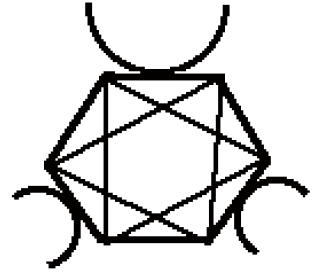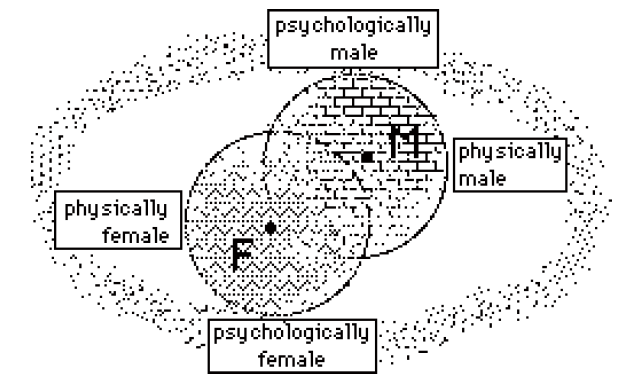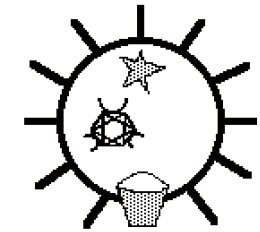The connection between scapegoats and SIOS will be apparent to the reader, in that scapegoats are usually the victims -- or rather the recipients -- of SIOS. However, the relationship is not entirely straightforward. Scapegoats usually exist within a syston, whereas SIOS is mainly directed to those outside the syston.
The Medium is the Message
In his wonderfully wide-ranging book Lifetide, Lyall Watson [Reference 25] considers various aspects of what we class as 'The Supernatural'. A review of the relationship of this area with MT is a later possibility, but for the moment we will dwell briefly on one aspect of the supernatural, that of seances.The concept of seances, where 'spirits are recalled from the Other World', usually through a human mediator called the Medium, is a familiar one. Seances were particularly popular in Victorian times, and they still go on today, even though the tendency of the modern veneer of sophistication is to reject them as 'unscientific', and therefore nonsense.
Watson reports a number of serious investigations of seances, and also an interesting technical fact. It appears that for successful manifestation of many apparently psychic phenomena, it is very important that a 'scapegoat' is present who can be blamed for anything that is viewed as bad.
This scapegoat might be a real person, or an inanimate object, but most often is an imaginary being, usually one from the Spirit World. By adopting this concept as a practical technique, Watson says, groups of perfectly ordinary people, without any psychic pretensions, are producing paranormal phenomena "simply by pretending that the rules of science don't exist".
Watson has been involved with a Canadian seance group in Toronto, who blame what they do on an imaginary ghost they call Philip. By consciously attempting to behave like children, singing rude and silly songs and regressing to a fantasy-world state, they have regularly produced phenomena such as levitation and rapping sounds, even on live television. These phenomena, they insist, 'tongue in cheek', are the results of Philip's responses to the bawdy conversations they hold with him.
The fact that some of these phenomena appear to be genuinely paranormal -- Philip's raps, for example, last only 0.16 of a second, one-third of the time a rap with your knuckles lasts -- are not of relevance here. What is important is the suggestion that anyone can produce such results through the use of a technique, one involving setting up a 'dummy' as a deliberate scapegoat.
A Little Oil
Some years ago I read a science fiction story about a group who were sent off on a long interstellar exploration expedition, one lasting some years. Naturally the group included a number of different specialists in the various scientific disciplines under study.In the story, which was called A Little Oil (I haven't been able to trace the author), as well as all the experts and qualified crew, there was what amounted to an odd-job man, who I will call Joey. Joey had to do all the routine stuff -- washing up after the cook, cleaning up the test apparatus after use -- which the highly qualified experts didn't have time for.
He wasn't always particularly good at these jobs, being noticeably accident-prone, and not infrequently made an utter fool of himself. Either he would trip over some minor object, crashing to the ground and covering himself with the remains of the team's last meal, or he would misunderstand some simple request and end up in a hopeless situation from which he had to be rescued, twittering and explaining.
As with any small number of people cramped together over a long time, tensions and disagreements arose among the experts in the group. Somehow, though, whenever things started to become really serious, the tension was usually relieved by a good laugh at Joey's latest catastrophe.
Finally, after many years, the work of the expedition was completed, and the ship returned to Earth. After the landing, the celebrations, and dispersal to their home parts, a secret came out. Joey was himself a specialist. He was a world-class circus clown. He had been drafted into the crew as a scapegoat.
Proposition 117A*. The functioning of a syston may be enhanced by the presence of a
specialist 'scapegoat' systel to which blame may be attributed
Someone to Look Up To
All right, what about the opposite to a scapegoat, somebody who gets all the praise? It seems to be that this, too, is an important systel function.In this article, I will call this specialist systel an 'Idol'. For a representational symbol, I will use a star (Figure 117.2). The usage of both these terms will be familiar to the reader, as with film idols, pop stars, and the like. As always with MT, though, their use will be applied throughout the matrix, to any level of syston.
As with scapegoats, idols may be of the most varied type. A useful attribute of an Idol is when it is not involved in any essential operation within its syston. In Britain, the arch-Idol for its inhabitants is probably still the Queen. The British monarchy, regarded as essentially above politics and not involved in the day-to-day running of the country, performs a valuable role as an Idol.
It is noteworthy that this Idol is not really an individual -- essentially it is a monarchy-syston, and its CEO, as it were, may change from time to time ("The King is dead, long live the King"). The symbol persists -- I was in the past called up as a juror, and was interested that the case was presented as the defendant versus "Our Sovereign Lady the Queen". And, of course, this syston-symbol often has a name, 'The Crown'.
In most cases, Idols are individuals, and this does mean that they have a limited life span.

An important feature of Idols is that they may have super powers. In Britain, and formerly in Australia, when all legal channels were exhausted, the last resort was an Appeal to the Sovereign. And in practice, without any legal or financial advantage, an Idol may be able to get something done solely because they are an idol -- they are surrounded by an aura which makes people want to support their beliefs. As an example, consider the success of film star Brigitte Bardot in reducing the slaughter of seals.
In a recent Australian television programme, Frank Blount, a US telecommunications executive, was asked about an episode in his past when he abandoned the industry to carry out an assignment involving public education. "The President asked my company to release me for that", he said. "You just don't say no to the President of the United States, at least in my country".
In MT terms, such logically unwarranted super-powers may not be a bad thing. Just as scapegoats provide a useful outlet for feelings of guilt or inadequacy -- a sort of sink for unwanted synenergy flows -- so too may idols provide a useful, clearly recognized target for other, perhaps excess, synenergy flows. And they may further benefit their syston by providing mechanisms for 'magical' powers -- powers beyond those usually recognized as normal for the syston.
Proposition 117B*. The functioning of a syston may be enhanced by the presence of a
specialist 'idol' systel to which praise may be allocated
Who Wants to be an Entrepreneur?
In the mid 1980's, it was quite common to see advertisements in Western Australia for talks and courses on 'How to Be an Entrepreneur'. Now, in the aftermath of continued revelations of business and government scandals, to be called an 'entrepreneur' amounts almost to an insult.Public perceptions can change very quickly. And so, a systel functioning as an idol can quite quickly become a scapegoat. The reverse is less common.
And the government systel we looked at in MT116 can also change from idol to scapegoat, seldom the other way. "It's all the Goverment's fault", isn't this a very common cry? Of course governments have a hard time remaining as idols because they are involved in the day-to-day running of their systons.
Readers will be able to identify other specialist types of systel operating. Here we will look at just one more type -- but a very important one.
Drilling Through Diamonds
Diamond is the hardest natural substance known. For this reason, it is unexcelled in wire extrusion dies, where a softened metal is forced like spaghetti through a tiny hole. Softer die material would wear much more quickly.But how to make the hole? Diamonds cannot be worked with normal materials, which are all softer, when a diamond is 'cut' it is actually just split along one of its natural lines of cleavage. The answer lies in the pulsed laser.
With this, a very high-energy pulse of light in a very narrow, parallel-edged beam is produced in the laser, and this has the power to actually burn through the diamond and produce an excellent smooth hole. The power is built up in the laser through a process called resonance or 'pumping'.
Another way of producing very high power levels is through optical focussing. For example, ordinary sunlight can actually melt a small piece of steel, if it is concentrated in a solar furnace -- essentially a giant magnifying glass.
In the MT apparatus we have built up so far, we have seen the parallels between everyday forms of power and energy and the phenomena involved in infocap and synenergy flows. In looking at a third type of specialist systel, we will again draw on these parallels.
Resonodes
The basis of this treatment is the suggestion that a type of systel operating in many systons has the ability to focus or amplify synenergy within itself, through some process of resonance. In a way, these systels are a bit like a computerized telephone exchange, taking in incoming connections and concentrating them into an optical-fibre cable connected to another distant exchange. They can be regarded as nodes within the general Matrix.
Proposition 117C***. Systons may contain elements which have the ability to focus
synenergy flows through internal resonance -- 'resonodes'
For this type of systel, I have had to coin a name, derived from 'resonance node', because I have not been able to find any really suitable parallel term in everyday life. A resonode, in the present interpretation, could also be called a focus-gate, or an emotion-concentrator, but these too are only made-up terms. We will get a better feel for the term by looking at some examples.
Earlier in this article we mentioned seances. In seances, the resonode is the 'medium', the gate and focus between the participants and the 'spirit world'.
Too airy-fairy? A more everyday example is found in the performing arts, particularly concerts. There, the conductor, perhaps described as a "brilliant interpreter of Mozart's score", is clearly doing more than just performing his own manual actions. Somehow he is able to focus all the efforts of the individual musicians and deliver a resonated product to the audience, and perhaps also channel back audience reaction, feedback, to the orchestra members.
Orchestral concerts, and indeed many large gatherings of people, generate a form of synenergy which is called 'atmosphere'. In MT124 I mention an instance of atmosphere at an Ella Fitzgerald concert, and its role in actual formation of short-lived systons.
Individuals with notable resonode abilities may be said to have 'charisma', or 'magnetic personalities'. Sometimes the exercise of this ability is resented, as when a woman claims that a man is "undressing her with his eyes".
Later in this suite of articles we will encounter other examples of Resonodes. As in the other specialized systels, they need not be individuals -- some research centres, for example, may be able to mobilize a whole industry or scientific discipline along some exciting development direction.
As usual, we will introduce a symbol for a Resonode (Figure 117.3). This symbol is intended to evoke the idea of a microwave dish unit receiving, processing, and transmitting information.

Going a Bit Far
Having got this far, we might as well go the whole way, and declare where all this is leading to. At the risk of being declared 'beyond the fringe', I will extrapolate and generalize the concept discussed with another big jump.
Proposition 117D****. Resonodes are the means by which systons interact with the
Matrix as a whole
We will not push this concept much more here, though it can be of relevance in discussing the 'supernatural'. This last word is, after all, only a tag applied to phenomena for which we do not have a satisfactory explanation, for which no clear mechanisms are available. Perhaps MT can move toward providing them.
For example, it starts to give a handle on such concepts as Rupert Sheldrake's 'morphic resonance'. According to this concept, when an advance is made in one part of the world, perhaps as little as a group in Liverpool learning some words out of a synthetic language or symbol set, it immediately becomes easier for a distant group in Australia to do the same thing -- like the presence of a minute 'seed crystal' enabling larger crystals to grow from a supersaturated solution. Actual tests of the 'morphic resonance' concept have given results tending to support it.
Something perhaps more readily acceptable is the notion that advances are made when 'there is something in the air'. Examples of parallel development of basic ideas, as with Newton and Leibnitz both coming up with the mathematical calculus, or with Darwin and Wallace independently hitting on the Theory of Evolution, are not especially hard to find. Whether such instances are purely a matter of the conditions being ripe, the solution being brought to supersaturation as it were, or whether there is more to it, is something we may hope to have clarification of in the future.
There is an observation concerning resonodes which may be helpful in explaining things that happen in human society. Functioning as resonodes is much more common with women than it is with men.
Why Can't a Woman ... Be More Like a Man?
"Why can't a woman be more like a man?". That was Professor Higgins' plaintive cry in 'My Fair Lady'. He could not understand why women had to be so illogical, so unpredictable, and so sensitive, not at all like "us regular chaps".And, on the other side of the fence, similar cries are heard. Why is it that men are so thoughtless, insensitive, and uncaring? Why won't they take responsibility for the children, why don't they appreciate all the work involved in running a house? And, above all, why won't they communicate?
There seems little doubt that huge catalogues of these characteristics could be compiled by those on either side of the Battle of the Sexes, which was looked at briefly in MT107. These weighty catalogues may be useful armaments for the two sides to throw at each during the course of this battle, but are they of any other use?
The relationship between the sexes must have been a concern of humans from their earliest days, and the ebb and flow of the battlefront has always been a topic of keen interest, or perhaps of great passion and indignation. A recent snapshot of this matter has been produced by columnist Ruth Ostrow [Reference 18].
Ostrow quotes a former man friend of hers: "You women want men to be sensitive and caring and read you poetry and massage oil into your feet after cooking you a nice meal. But then you get shitty if the man isn't out building empires. If he is out building empires and slaying dragons to protect you and buy you nice things, you get shitty he hasn't got the energy to read poetry, see art films with you or make love all night. You're all the same. You set up this impossible catch-22. Who needs it?".
Ostrow comments:"My women friends sit around huffing, puffing and sighing. They have heard it all before. All have had to deal with men going physically or emotionally AWOL. All, at some stage, asked for a deserved commitment that was never given.
The lessons for women in the '90s seem to be: listen to what men are asking of us; accept the brutal reality that we are very different; learn to let go."
Wise words, perhaps. From the MT viewpoint, the middle piece of advice is the most important. Men and women are very different.
No doubt the existence of some physical and psychological differences has always been obvious. But an increasing number and range of such differences are becoming apparent. Clair McIntosh [Reference 14] says that "researchers in dozens of fields, from neurobiology to psychology to linguistics, are discovering more and more areas in which the sexes seem to part company".
McIntosh tags the differences as follows: "She lives longer; She sleeps better; He's longwinded; She's verbal, He's visual; She gets more migraines; She sings blues, He tunes out; She weighs all the facts; She can't drink as much; She gets assertive with age, He gets softer; She gives more gifts; He changes the channel; He says "I'm sorry"; He's more likely to be violent; She's more sensitive and intuitive; He runs faster (but She's gaining)";and finally [who could believe this?],"He's so vain".
Stand Back Three Paces
All right, let us back off and apply a bit of MT to this situation. First of all, Professor Higgins' dire plaints and those from the other quarters are not much help. They identify male/ female differences, sure, but they then make an unwarranted step. That step says, "You are different to me; I am right; therefore you are wrong".And from this unwarranted step derives most of the fire which fuels the Battle of the Sexes. It is an expression of the SIOS which permeates all systons. In MT terms, the step is unjustified because it goes against basic MT assumptions that diversity is best (eg Proposition 109A), and that syston task-sharing is better allocated in a complementary way (eg Propositions 107A and 107C).
In another derivation, it seems reasonable that the differences between men and women have continued in existence, rather than being bred out by natural selection, because they perform some useful role for the race. The syston benefits from the diversity of the systels, however inconvenient that may be for them, and the diversified syston survives preferentially over other systons without that diversity.
Male/female relationships are such an important part of human society that we might spend another Proposition for this particular case.
Proposition 117E*. Men and women have different characteristics, both physical and
mental, because the consequent diversity is of value to society
Children and Dogs Always Know
Back to the main theme of this article. We have looked at the operation of specialist systels, and I have suggested that women are more effective as Resonodes than are men.Look at the characteristics ascribed to women -- sensitive; intuitive; communicating. All these things suggest that women, generally, have an effective way of interacting with the Matrix. They are better at delivering emotions, providing the glue in the person-mix of society, adding 'a little oil'. Of a friend of ours, the only girl in the family, her brother said "Alli holds the family together".
The characteristics of women have another facet: illogicality. The straight male SIOS interpretation of this is that it is Bad. The MT interpretation is that resonoding is a valid method of interacting with the Matrix, perhaps as powerful in its own right as the Scientific Method which is more the preserve of men. In an expression of Proposition 107C, the two systems dominate society, both competing and complementing.
Look where women predominate. The medium in a seance is almost always a woman, the fortune-teller or clairvoyant, the seer in the ancient temple, all are usually women.
So far I have referred to men and women, rather than males and females. It is an interesting physiological fact, that men undergo one more development stage than women. While there are obvious differences from birth, boy and girl children may be psychologically more similar to each other than they are to adults. All children tend to have imaginary friends, tend to see monsters in the shadows, tend to play-act, whatever their sex.
As they grow older, the boys differentiate from the girls, their voices break, their body hair proliferates, their muscles grow. Physically, the girls are left behind, behind a physiological and psychological hump which only the boys surmount.
A friend once said to me "Children and dogs always know what is going on in a family". It may be, that as boys mature, they lose some of their resonoding ability as they move into the apparatus of logic. Resonoding may fall off with age.
Proposition 117F*. As systels move through their development cycle, their ability to act
as resonodes may diminish
Dividing up South America
In 1493 Pope Alexander VI (perhaps the most unusual pope in history) signed a Papal Bull which divided the lands of the New World between Spain and Portugal -- including South America, which was yet to be discovered. The Pope's five acknowledged children included a son who rose to the rank of Cardinal (on his own merits?), and was accused of murdering his older brother -- a Duke. The Duke's stabbed body was found floating in the Tiber. There was also a daughter, Lucrezia Borgia, one of history's most acknowledged experts on poisoning.The Pope's action is ultimately the reason why Brazil speaks Portuguese, and the other South American countries Spanish. Let us now try to emulate the Pope, and divide up the Matrix World into two portions, male and female.
To get a 'feel' for the male/female relationship in the MT picture, we can construct another example of a matrix cocoon (Figure 117.1). In this picture, male and female are each represented by a circle within the cocoon. This representation is a flat, two-dimensional one. In actual fact, instead of a flat circle, each gender could be represented by a round mountain, so that the bell curves in Figure 109.3 would be a cross-section across these mountains. The circles would then be replaced by contour lines, and the points F and M would be the peaks of these mountains.

But that is perhaps complicating things too much. The important thing to get over is the idea that when we talk about 'men' and 'women' we tend to identify these concepts as the points M and F in the picture. In actual fact, they are far more spread out, more diffuse, and -- a very important point -- they are also overlapping
This two-dimensional representation can be used to plot the position of a particular systel, a particular individual in this case. Only women who are very close in both physical and psychological makeup to the mode -- the most common situation for women -- will be at the mountain peak F. If they differ from the 'norm', which sits where the point F is, in common parlance, they will be further out towards the edge of their circle, towards the foot of their mountain.
In this picture, physiologies which are more female are to the left, more male to the right. Psychologies which are more male are to the top, those more female to the bottom. This picture gives a visual representation to the matters which were discussed in MT109.
A typical linear view of the situation would see only the mountain peaks F and M, all else is obscured by a rising mist of complexity. In practice, we are not quite as tight-banded as this. McIntosh, for example, is at pains to point out that rules about men as a group, or women as a group, are frequently contradicted by individual examples.
Life in the Col
In the common view of the Battle of the Sexes, the opposing forces are camped at strategic positions on the tops of mountains F and M, firing fusillades of accusations at each other.Those who live in the extreme southwest or northeast are somewhat shielded from the action. Although they are far-out, at least they know where they stand -- they have a clear F or M written on their bellies.
Those living on the approaches to the pass between the mountains are in a more difficult position. Often they are not certain which mountain they are on -- the boundary is not particularly clear. A common saying is that they do not know whether they are arFur or Martha.
Those living right in the Col itself, the part of the pass directly on the line between F and M, are in the most hazardous position of all. They can take it for granted that SIOS will repel them from both of the safe hilltop keeps.
And yet these Col Dwellers possess some of the most valuable gifts, in the form of less usual combinations of characteristics. These combinations allow them to carry out functions in society not possible for those having only some of their characteristics.
Proposition 117G*. Homosexuals can perform valuable roles in society because they
have less usual combinations of characteristics which suit them for these roles
Here then are reasons for why homosexual elements continue to exist in human society. An explanation of why homosexual men are unusually common in the resonoding roles -- acting, painting, conducting, cooking, writing -- functions which need the ability to interact in a non-logical way with the Matrix as a whole. And why women homosexuals may be prominent, not only in clearly physical arenas such as sports, but also in 'logical' areas such as the hard sciences.
Perhaps it is still necessary, even here, to emphasize that nothing in the above is intended even remotely to imply that all male actors are homosexuals, or all female scientists are lesbians. Nor is it intended to imply that homosexuality should be encouraged.
As always with MT, there is only a view over an undulating and extensive sweep of ground. Within this view, there is an observation that only relatively few people are able to fully embrace both the rational, logical, and confined approach more typical of men, and also the intuitive, sensitive, and far-reaching approach more common in women. Usually, it seems, one approach necessarily displaces the other.
It may be appropriate at this point to try and encapsulate the MT response to such questions as "Which are best, men or women?", or "Which is best, science or the arts?", or "Which is best, logic or intuition?". The MT answer to all these questions is "Yes".


